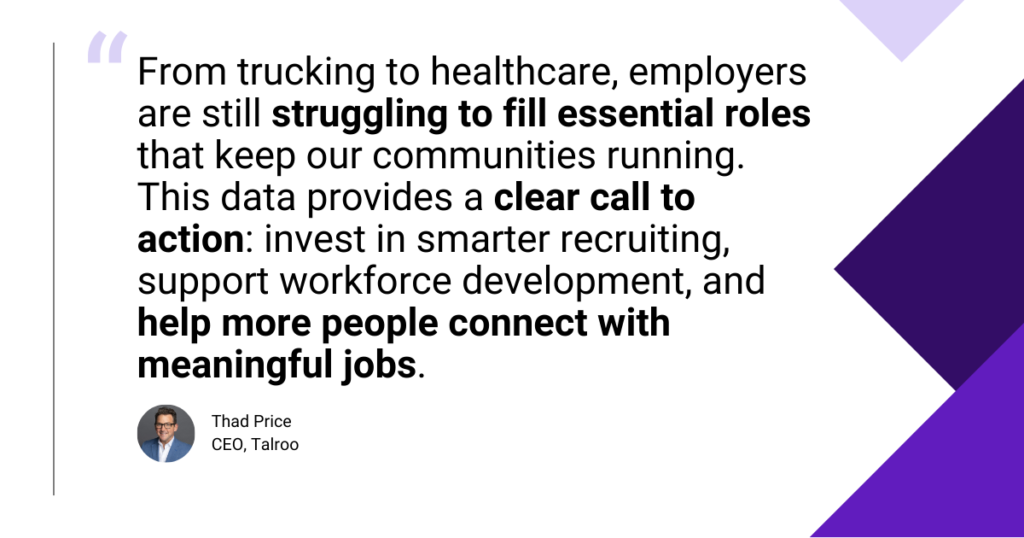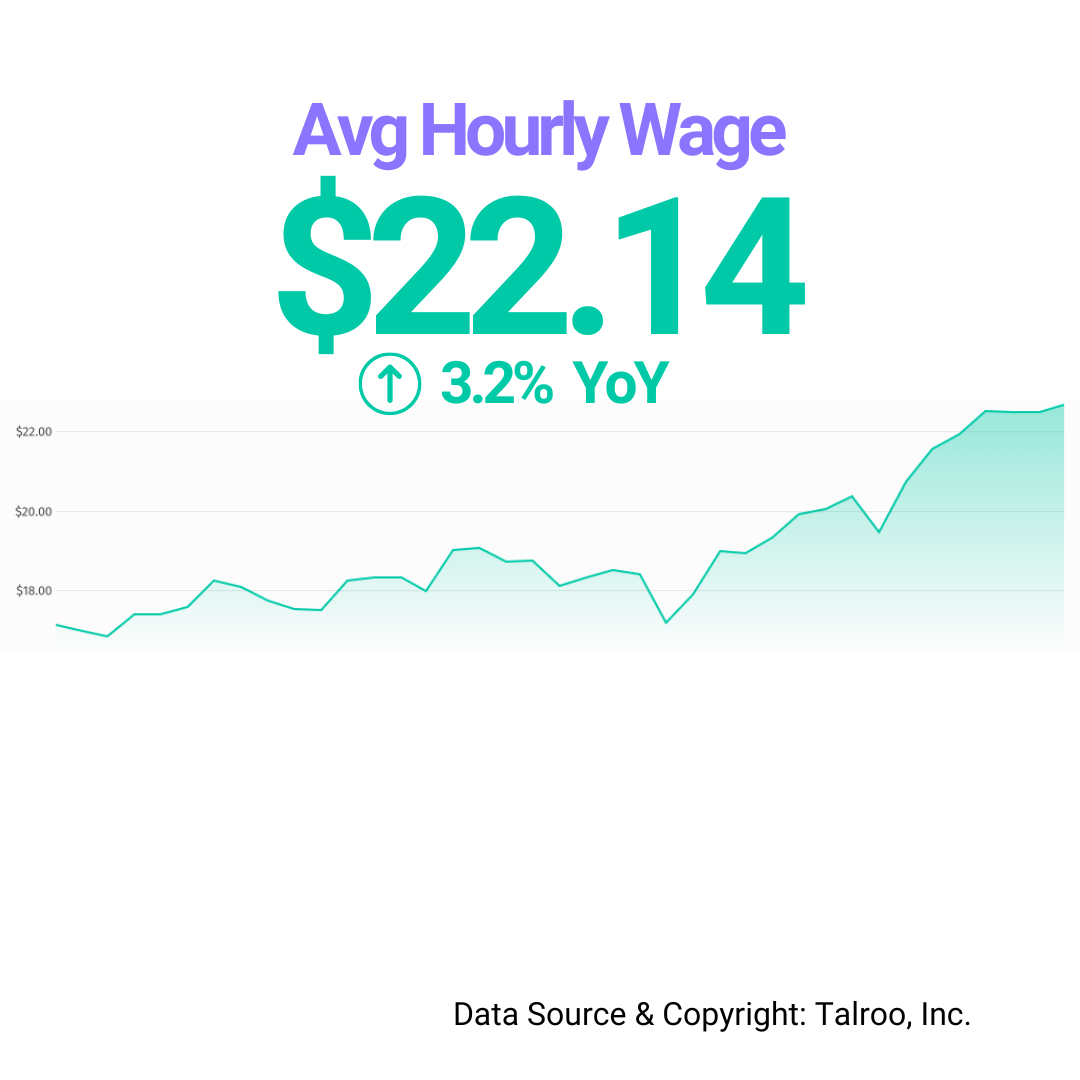Talroo's Frontline Worker Index
Frontline Worker Index: Executive summary (Q1 2025)
Hiring Demand. Wage Growth. Talent Gaps.
The frontline job market started 2025 with strong momentum. Job postings rose in nearly every major industry—up 5% from Q4 2024—but candidate availability continues to lag, especially in trucking, allied healthcare, caregiving, and customer service roles.
At the same time, wages are rising faster than the national average in 6 of the top 10 frontline industries, with dramatic spikes in high-demand sectors. Trucking wages rose 16% year-over-year, and warehousing pay jumped 15%, reflecting employers’ growing urgency to fill critical roles.
• Supply & Demand: Both resume postings (worker supply) and job postings (employer demand) increased significantly year-over-year.
• Wages & Pay: Average hourly wages climbed to $22.14, with several key industries beating the average national 3.8% compensation growth rate (BLS).
• Schedules, Hours, & Remote Work: Full-time roles held steady at over 84% of all postings, reflecting employer demand for stable, long-term hires. Remote work options expanded, with remote-eligible postings increasing to 4.4%, up from 4.2% in Q4 and 4.1% YoY
Frontline Worker Index Explorer
To explore Talroo’s data and search findings for recruiting and hiring, use the Industry Explorer below. You can view nationwide trends or focus on specific states. Additionally, you can narrow your search by selecting industries or specific job titles. Happy searching!
Key Quarter-over-Quarter Trends: Q1 2025 vs Q4 2024
- Hiring Demand Climbs: Job postings rose 5% quarter-over-quarter, reaching their highest level since 2022.
- Remote Work Ticks Up: Average remote-eligible roles increased to 4.4%, up from 4.2% in Q4.
- Bonus Offers Surge: Average bonuses offered rose 2.3%, hitting a new high of $3,099 per role.
- Wages Continue to Climb: Average hourly wages increased +0.9% quarter-over-quarter, to $22.14.
Year-over-Year Trends (Q1 2025 vs Q1 2024)
- Job Postings Jumped 58%: The number of job opportunities exploded from 154.8M to 244.9M.
- Remote Options Up 9% YoY: As flexibility becomes a key differentiator, more industries offer WFH.
- Wages Outpacing Inflation: Average hourly pay rose 3.3%, compared to the national average compensation growth of 3.8% (BLS).
Insights for Employers & Job Seekers
According to Talroo and Resume Now’s joint analysis:
- Resume optimization with industry-specific keywords, certifications, and scheduling availability can give candidates a meaningful edge.
- Employers are facing more pressure to compete on wages, scheduling flexibility, and bonuses—especially in logistics, healthcare, and food service.
- Job seekers with skills in CDL operation, OSHA safety, caregiving, or patient care are well-positioned to find competitive roles in 2025.
The Frontline Worker Index Data & Findings
The Frontline Worker Index (FWI) provides valuable data on key factors like supply and demand, job titles, wages, work schedules, education and experience requirements, and the benefits frontline workers value most. By analyzing these insights, HR professionals and recruiters can develop more effective strategies for attracting, hiring, and retaining top talent in today’s highly competitive job market.
Supply & Demand
The FWI compares new resumes and new job posts to show the balance between job seeker supply and employer demand.
As tracked by Talroo’s Frontline Worker Index, featuring proprietary first party data in addition to Public Insight Data, the following industries had the largest mismatch between job demand and candidate supply in Q1 2025:
- Trucking
- Allied Healthcare
- Caregiving
- Customer Service
- Manufacturing
- Retail
- Administrative
- Sales
- Food Services
- Warehousing
Wages & Pay
This dataset shows the average wage and sign-on bonus for jobs listed on the Talroo Ad Platform, and reflects significant regional discrepancies in states like California and New York. These states with strict salary transparency laws may skew the average wage data. In contrast, states with fewer transparency requirements remain underrepresented.
Where Wages Are Rising Fastest
Six of the top 10 frontline industries saw wage growth above the national average. Notably:
- Trucking saw a 16% spike, reaching an average of $25.49/hour.
- Warehousing rose 15% YoY, now averaging $19.78/hour.
- Administrative roles jumped 10%, with pay reaching $22.13/hour.
- Customer Service, Caregiving, and Retail all saw gains between 7–10%.
“Wages are rising faster than the national average in 6 of the top 10 frontline industries.”
Schedules, Hours, & Remote Work
This dataset shows the indexed Work from Home, Part-Time, and Full-Time positions listed by clients on the Talroo Ad Platform. It’s important to note that some positions may be listed as part-time or full-time based on availability or store needs, but this doesn’t necessarily affect the overall numbers.
How Schedules and Work Flexibility Are Shifting
Q1 2025 data reveals clear trends in scheduling preferences and flexibility:
- Full-time roles remain dominant, accounting for over 84% of all job postings, a signal that employers continue to prioritize long-term, stable hires.
- Remote-eligible roles increased to 4.4%, up from 4.2% in Q4 and 4.1% YoY—indicating a slow but steady expansion of remote and hybrid options even in traditionally on-site industries.
- Part-time opportunities remain limited, showing continued employer preference for full-time staffing models.
“Frontline organizations are doubling down on full-time roles—while remote work continues to quietly expand.”
Education & Experience
This index tracks Talroo clients who post jobs that do not require formal education or previous work experience. For example, roles such as warehouse workers or food service employees often fall into this category.
Both the No Degree Required and No Experience Required indices have experienced declines over the past month. The No Degree Required index dropped by 5 points, and the No Experience Required index fell by 1 point year-over-year, though it saw a 2-point rise month-over-month. These trends suggest that more employers are requiring degrees or experience for frontline jobs, possibly indicating a shift towards more stringent hiring criteria as businesses seek candidates with stronger qualifications.
Explore the graphs below to see how these requirements vary by state or industry:
What’s Required: Education & Experience Trends
Q1 2025 shows a gradual shift toward more inclusive hiring criteria:
- Experience required stayed relatively flat, with many industries maintaining similar expectations year-over-year. However, roles not requiring prior experience remained high in volume—especially in caregiving, food service, and warehouse roles.
- Educational barriers continue to lower. Many frontline job postings did not require a college degree, and roles requiring no formal education made up a significant share of openings across retail, warehousing, and transportation sectors.
- The average education level requested remained steady, suggesting that while specialized roles still exist, the overall barrier to entry is decreasing in many frontline industries.
“Employers are wisely opening doors by emphasizing skills over degrees and experience.”
Data Source & Copyright: Talroo, Inc.
The Frontline Worker Index Report: Methodology
Talroo processes an average of 26 million job posts every month, with over 187 million data points adding to this index directly. This extensive dataset is sourced first-party directly from Talroo, reflecting a broad spectrum of industries and geographic locations. Some job posts are comprehensive while others are less detailed; our goal is to encourage companies to be more transparent and intentional with their job posts to improve data quality and utility.
The FWI reflects information from a wide range of sectors, powered by Talroo’s robust dataset and supplemented with Public Insight Data. The report includes detailed graphs and data points, offering a clear view of how different industries are managing tight labor markets and legislative changes for frontline roles. It’s important to note that our data does not reflect all positions equally; some job posts may represent a need for one hire, while others might represent a need for 1,000.
Index numbers are based on January 2022, a point of relative stability in a post-pandemic world for frontline workers.
This set of indices is an invaluable resource for HR professionals, recruiters, business leaders, and investors seeking to understand and navigate the complex landscape of frontline and essential workforces. It provides actionable insights that can help benchmark past and current performance, as well as forecast near-term industry trends and outlook.
Frontline Worker Index Archive
View the April 2024 FWI Report here →
View the June 2024 FWI Report here →
View the July 2024 FWI Report here →
View the August 2024 FWI Report here →
View the September 2024 FWI Report here →



